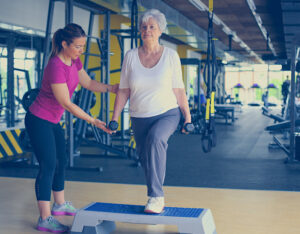
Falling is a major fear about growing older – and it’s a leading cause of injury and death among mature adults. It’s also a common problem for people who don’t yet consider themselves “old” in the traditional sense.
But it is not inevitable. Here are the top five ways to prevent falls, according to fitness, health and aging experts.
How to Prevent Falls
No. 1: Exercise
The US Preventive Services Task Force couldn’t be clearer: Exercise is the best defense against falling. Merely staying active helps, but exercising more than three hours a week lowers fall risk by 39 percent.
Movement includes anything you do consistently, even walking or cleaning house. But you also need to add resistance training (also known as strength training), which includes weightlifting and resistance bands. The goal isn’t to get big muscles. It’s to keep you strong enough to prevent falling.
We all lose muscle later in life. Having less strength makes it hard to catch yourself when you trip (which everyone does, regardless of age). And muscle protects bones, so without it, we are vulnerable to breaks.
- Strengthen your legs. Now. Even if you’re only in your 40s, 50s or 60s.
- Practice balancing – again, regardless of age. It’s never too early. It’s a skill that can improve with practice.
- Exercise helps prevent and treat Type 2 diabetes, which can cause nerve loss and damage in the feet – which makes it hard to stay upright.
- Every time you exercise, you’re improving your body’s ability to move blood to extremities. And you’re helping your brain’s ability to process where you are in relation to other objects as you move.
- Our back, hip, and abdominal muscles are collectively part of the core. We need it strong for all kinds of reasons. Balance is at the top of them. Core strength allows us to move well at the hip, knee and ankle.
No. 2: Mind the Prescriptions
Did you know your risk of falling increases if you take four or more prescription medications? So, talk to your doctor and make sure she knows everything you’re taking and why. Don’t assume she’s aware and closely monitoring the list. That’s your responsibility.
No. 3: Fall-proof Your Home
Sixty percent of falls occur at home, the National Institute on Aging says. Remove clutter. Clear walkways of loose throw rugs and electrical cords. Install nightlights. Add support rails in the tub or shower.
No. 4: Wear the Right Shoes
Don’t use flip-flops, even on vacation. Wear high heels only indoors, if at all. Get some good walking and exercise footwear. Walking barefoot on occasion, even indoors, can also help improve proprioception, which improves balance.
No. 5: Eat Well
Protein, calcium and vitamin D are good ideas – but are not miracle cures or preventions. Use alcohol in moderation if at all. You can learn to plan balanced meals with a complimentary 5 day email course to help improve your diet.
Exercise to Prevent Falls
Don’t let concern about falling prevent you from enjoying life as much as you can. And don’t put it off as just a worry “for those really old folks.”
Strength and balance are essential throughout life. Don’t wait until things become difficult before addressing it. Adding strength training to your regular routine may literally save you hundreds of thousands of dollars if it delays or eliminates the need for assisted living or skilled nursing care, which is commonly needed after a fall.
I’m here to guide you to a healthy lifestyle that includes safe, effective exercising. Request 15 minutes of my time below and we can schedule a complimentary consultation to see how I can help you improve your strength and balance.
